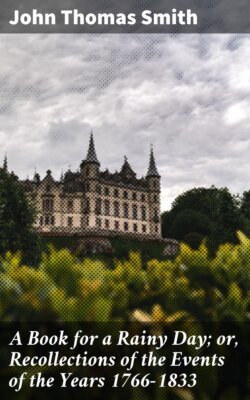Читать книгу A Book for a Rainy Day; or, Recollections of the Events of the Years 1766-1833 - John Thomas Smith - Страница 4
На сайте Литреса книга снята с продажи.
THIS EDITION
ОглавлениеTable of Contents
The first two editions of A Book for a Rainy Day appeared in 1845, twelve years after John Thomas Smith’s death, and a third appeared in 1861. As these editions do not contain half a dozen notes other than Smith’s own, this may claim to be the first annotated edition. It is also the first in which numerous original misprints have been (as I hope) corrected.
The lapse of seventy years has made many notes necessary. I have endeavoured to write these in the spirit of the book, making them something more than brief categorical answers to questions suggested by Smith’s journal. His own notes were interesting after-thoughts, and for this reason, and to avoid confusion, the great majority are now incorporated in his text. Where any are retained as footnotes, Smith’s authorship is indicated. If my additions to the book seem profuse, I can only plead that the Rainy Day offers to the annotator that abundance of material which has long pleased and bewildered its “Grangerisers.” And our climate has not improved.
I wish to acknowledge the use I have made of the Dictionary of National Biography, Notes and Queries, Mr. Wheatley’s London Past and Present, Mr. George Clinch’s Bloomsbury and St. Giles’s, and his Marylebone and St. Pancras, Mr. Warwick Wroth’s London Pleasure Gardens of the Eighteenth Century, Mr. Percy Fitzgerald’s Life of Garrick, Mr. Austin Dobson’s Hogarth, Mr. Laurence Binyon’s Catalogue of Drawings by British Artists in the Print Department, the Gentleman’s Magazine, the works of Cunningham and Redgrave, and such autobiographies as those of Henry Angelo, Thomas Dibdin, John Taylor, W. H. Pyne, Sir Nathaniel Wraxhall, B. R. Haydon, Madam D’Arblay, Dr. Trusler, and Letitia Hawkins. It is remarkable how John Thomas Smith’s own books supplement each other. His Nollekens and his Times is an inexhaustible budget of facts, and its usefulness has been increased by the index provided in Mr. Gosse’s edition of 1895.
It should be remembered that the year-dates which Smith uses as chapter headings do not represent the times at which the respective chapters were written. I judge that Smith was engaged on the Rainy Day only in the last three years of his life. His chronology is rather happy-go-lucky. For example, it must not be supposed that Dr. Burgess, of Mortimer Street, wore his cocked hat and deep ruffles in 1816, or that in that year Alderman Boydell might have been seen putting his head under the pump in Ironmonger Lane. These men died some years earlier. In accordance with the text of the third edition, Smith’s curious mention of the death of Dr. Johnson will be found under the year 1803.
W. W.
June 1905.
